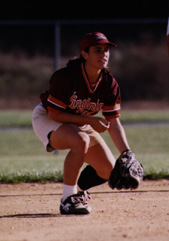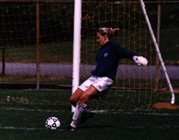ATHLETICS
Women's sports on fast track
by Cassie Arner
When the National Collegiate Athletic Association (NCAA) began enforcing gender equity issues nearly five years ago, some universities chose to equalize the gender balance by phasing out certain men's sports. But athletic director Dave Braine and the Virginia Tech athletic department decided the program needed to grow to bring better opportunities for Hokie athletes of both genders. Tech is now among the top 10 universities in its proportion of female athletes, according to a Chronicle of Higher Education survey.
 In 1993, when Virginia Tech joined Texas, Auburn, and many other prestigious universities being sued by the NCAA for noncompliance with the Title IX Act (that prohibits educational activities from excluding or discriminating on the basis of gender), Braine and other administrators already had begun to add three new women's sports into the 18-sport program. The plan also called for a 19-percent increase in scholarships and 12-percent increase in participation during a three-year period.
In 1993, when Virginia Tech joined Texas, Auburn, and many other prestigious universities being sued by the NCAA for noncompliance with the Title IX Act (that prohibits educational activities from excluding or discriminating on the basis of gender), Braine and other administrators already had begun to add three new women's sports into the 18-sport program. The plan also called for a 19-percent increase in scholarships and 12-percent increase in participation during a three-year period.
Women's soccer was added in the fall of 1993, and women's lacrosse began competition in the spring of 1995. Women's softball completed the plan a year later. Basketball, volleyball, tennis, swimming and diving, cross country, and indoor and outdoor track round out the list of 10 women's sports.
Three-time NCAA All-American Sam Okpodu was hired in 1993 as Tech's first women's soccer coach and led the non-scholarship team to a 6-10-1 record in its inaugural season. The squad posted an 8-11 mark with a winning home record of 4-3 in its second season.
In 1995, the Hokies were introduced to stiffer competition as they joined the Atlantic 10 Conference. The 3-12-3 soccer record that season was the worst in the sport's short three-year history. But, led by junior goalkeeper Hope Handley and freshman Shannon Otto, the 1996 team posted a 9-9-1 record and a fourth-place finish in the western division of the A-10, falling one team short of a berth in the four-team conference tournament.
 With the final increase in scholarships this academic year, women's soccer meets all requirements for financial aid set by the NCAA.
With the final increase in scholarships this academic year, women's soccer meets all requirements for financial aid set by the NCAA.
For head coach Dipi Bhaya's lacrosse team, the waiting period for success was only one year. After the inaugural season's 2-7 record, Bhaya added 12 newcomers to produce a winning season in the sport's second year. Led by sophomore Amy Mantooth in her second 30-plus-goals season, the Hokies posted a 7-6 record. Women's lacrosse will meet NCAA requirements with 12 full scholarships by the 1998 season.
An all-conference player, a two-hit shutout, and an eight-game winning streak were just some of the highlights of Tech's first women's softball season. Head coach players racked up a 16-32 record not indicative of the progress made in just one season. Senior shortstop Melissa Sanderson finished the season ranked eighth in the nation in triples, on her way to becoming Tech's first all-Atlantic 10 player. Throwing a two-hitter, senior Tina Diamond pitched the school's first shutout in a 4-0 win over Cornell.
Like lacrosse, softball will receive its full allotment of scholarships in time for competition in the spring of 1998.
When construction is complete, Virginia Tech will offer first-rate athletic facilities for all male and female athletes. Both the men's and women's indoor track teams hosted meets on a brand new, state-of-the-art Mondo track. The $500,000 track is one of four in the nation of its quality.
By the spring of 1998, the outdoor track team will be competing on an outdoor facility of the same quality. The facility will also include a field for soccer and lacrosse teams in the center of the track. The softball field, under construction, will be ready for the 1998 season. Additional weight room and athletic training facilities will be available with the building of the Merryman Complex.
Cassie Arner is an assistant sports information director.
Home | University News | Features | Research | Philanthropy | President's Message | Athletics | Alumni | Classnotes | Editor's Page

 In 1993, when Virginia Tech joined Texas, Auburn, and many other prestigious universities being sued by the NCAA for noncompliance with the Title IX Act (that prohibits educational activities from excluding or discriminating on the basis of gender), Braine and other administrators already had begun to add three new women's sports into the 18-sport program. The plan also called for a 19-percent increase in scholarships and 12-percent increase in participation during a three-year period.
In 1993, when Virginia Tech joined Texas, Auburn, and many other prestigious universities being sued by the NCAA for noncompliance with the Title IX Act (that prohibits educational activities from excluding or discriminating on the basis of gender), Braine and other administrators already had begun to add three new women's sports into the 18-sport program. The plan also called for a 19-percent increase in scholarships and 12-percent increase in participation during a three-year period. With the final increase in scholarships this academic year, women's soccer meets all requirements for financial aid set by the NCAA.
With the final increase in scholarships this academic year, women's soccer meets all requirements for financial aid set by the NCAA.